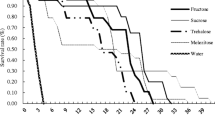“Durch die Zugabe von Antiwuchsstoffen können wir nachweisen, daß das Wachstum der betreffenden Organismen gehemmt wird, und daß diese Hemmung durch die Zugabe des entsprechenden Wuchsstoffes wieder aufgehoben wird”.
Abstract
The flour miteAcarus siro L. (Acaridae, Astigmata) was reared on an axenic diet with the addition of various nutrient antagonists, with and without supplementation by the corresponding nutrients. The deficiency symptoms induced by dietary antagonists, and the reversibility of the former by nutrient administration, indicated that folic acid, riboflavin, thiamine, niacin, pyridoxine, biotin and a sterol are essential for the growth and reproduction of the flour mite. It was also demonstrated that the population density and generation sequence of this species can be suppressed to the level of acaristasis by nutrient antagonists, owing to inhibited nutrient utilization.
Similar content being viewed by others
References
Griffiths, D. A., Bull. British Museum (Natural History) Zool.2 (1964) 413.
Hughes, A. M., The mites of stored food and houses. Her Majesty's Stationary Office, London 1976.
Solomon, M. E., Ann. appl. Biol.50 (1962) 178.
Hughes, T. E., Mites or the Acari. Athlone Press, University of London 1959.
Levinson, H. Z., Levinson, A. R., and Müller, K., Anz. Schädlingskde, Pflanzenschutz, Umweltschutz64 (1991) 55.
Knülle, W., Mitt. zool. Mus. Berlin35 (1959) 347.
Zacher, F., Die Vorrats-, Speicher-und Materialschädlinge und ihre Bekämpfung. Verlagsbuchhandlung Paul Parey, Berlin 1927.
Boczek, J., and Davis, R., Exp. appl. Acarol.1 (1985) 213.
Szlendak, E., Boczek, J., Bruce, W., and Davis, R., The Florida Ent.68 (1985) 286.
Levinson, H. Z., Z. angew. Ent.81 (1976) 113.
Rodriguez, J. G., and Potts, M. F., Nutritional requirements and metabolci inhibition of some acarid mites. Proc. 1. Intern. Work. Conf. Stor. Prod. Ent. pp. 160–166 (1975).
Smallman, B. N., J. econ. Ent.38 (1945) 106.
Levinson H. Z., Barelkovsky, J., and Bar Ilan, A. R., J. stored Prod. Res.3 (1967) 345.
Wal, Y. C., Perti, S. L., and Agarwal, P. N., Labdev. J. Science Technol. India9b (1971) 212.
Gothilf, S., and Waites, R. E., Ent. exp. appl.11 (1968) 261.
Levinson, H. Z., and Bergman, E. D., Biochem. J.65 (1957) 254.
Pratt, J. J., House, H. L., and Mansingh, A., in: Insect and Mite Nutrition, pp. 651–668. Ed. J. G. Rodriguez. North-Holland Publ. Co., Amsterdam 1972.
Fraenkel, G., and Blewett, M., Trans. R. Ent. Soc. Lond.93 (2) (1943a) 457.
Fraenkel, G., and Blewett, M., Biochem. J.37 (1943b) 695.
Levinson, H. Z., Levinson, A. R., and Oelkler, U., Naturwisenschaften76 (1989) 176.
Sachs, L., Angewandte Statistik, 6th edn., Springer Verlag, Berlin/ Heidelberg/New York 1984.
Griffiths, D. A., Nature196 (1962) 908.
Solomon, M. E., Ztschr. Pflanzenkrankh. Pflanzensch64 (1957) 606.
Bowman, C. E., in: Acarology 6, vol. 2, pp. 933–1001. Eds D. A. Griffiths and C. E. Bowman. E. Horwood, Chichester 1983.
Griffiths, D. A., and Boczek, J., Int. J. Insect Morphol. Embryol.6 (1977) 231.
Woolley, D. W., A Study of Antimetabolites. J. Wiley, New York 1952.
Woolley, D. W., in: Metabolic Inhibitors, a comprehensive treatise, vol. 1, pp. 445–480. Eds R. M. Hochster and J. H. Quastel. Academic Press, New York/London 1963.
Somogyi, J. C., (Ed.), Antivitamins. Bibliotheca Nutritio et Dieta, no. 8. S. Karger, Basel/New York 1966.
Windaus, A., Berichte42 (1909) 238.
Altman, P. L., and Dittmer, D. S., (Eds), Biology Data Book. Fedn Am. Soc. exp. Biol. Washington, D. C. (1964).
György, P., and Rose, C. S., Proc. Soc. exp. Biol. Med.49 (1942) 294.
György, P., and Rose, C. S., Proc. Soc. exp. Biol. Med.53 (1943) 55.
Fraenkel, G., and Blewett, M., J. exp. Biol.22, (1946) 172.
Leclercq, J., Biochim. biophys. Acta2 (1948) 614.
Levinson, H. Z., and Levinson, A. R., EPPO Bull.15 (1985) 43.
Author information
Authors and Affiliations
Additional information
Nielsen, N., Wuchsstoffe und Antiwuchsstoffe der Mikroorganismen. Verlag Gustav Fischer, Jena 1945.
Rights and permissions
About this article
Cite this article
Levinson, H.Z., Levinson, A.R. & Offenberger, M. Effect of dietary antagonists and corresponding nutrients on growth and reproduction of the flour mite (Acarus siro L.). Experientia 48, 721–729 (1992). https://doi.org/10.1007/BF02124287
Received:
Accepted:
Published:
Issue Date:
DOI: https://doi.org/10.1007/BF02124287




